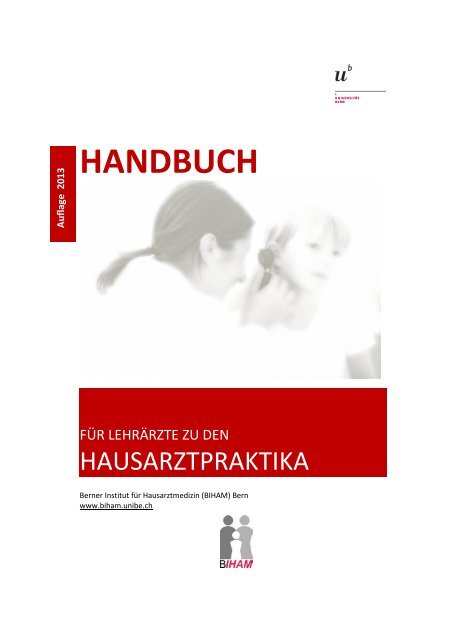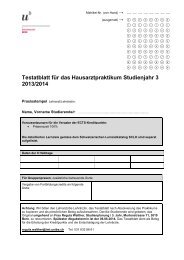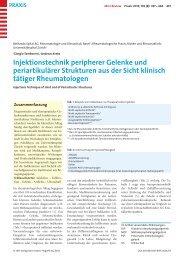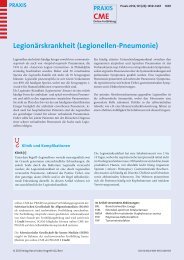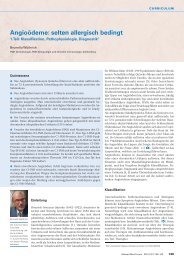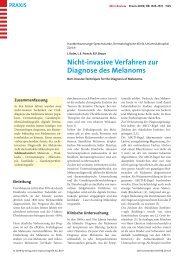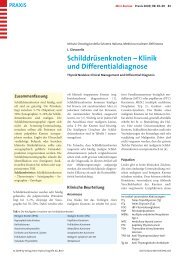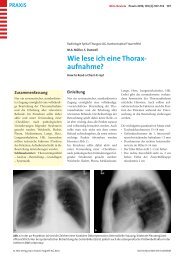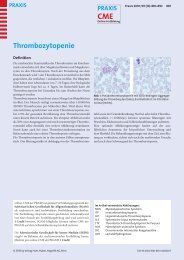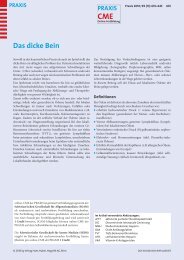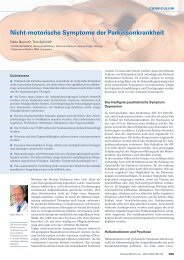Handbuch 2013 (pdf, 736KB) - Berner Institut für Hausarztmedizin ...
Handbuch 2013 (pdf, 736KB) - Berner Institut für Hausarztmedizin ...
Handbuch 2013 (pdf, 736KB) - Berner Institut für Hausarztmedizin ...
Erfolgreiche ePaper selbst erstellen
Machen Sie aus Ihren PDF Publikationen ein blätterbares Flipbook mit unserer einzigartigen Google optimierten e-Paper Software.
Auflage <strong>2013</strong><br />
HANDBUCH<br />
FÜR LEHRÄRZTE ZU DEN<br />
HAUSARZTPRAKTIKA<br />
<strong>Berner</strong> <strong>Institut</strong> <strong>für</strong> <strong>Hausarztmedizin</strong> (BIHAM) Bern<br />
www.biham.unibe.ch
<strong>Berner</strong> <strong>Institut</strong> <strong>für</strong> <strong>Hausarztmedizin</strong> BIHAM<br />
Dr. med. Mireille Schaufelberger<br />
Leiterin Lehre<br />
Lis Tomaschett<br />
Sekretariat Lehre<br />
Titelbild: Shutterstock<br />
Skript
1. Einführung<br />
2. Das Medizinstudium Bern<br />
3. Hausarztpraktika<br />
4. Lernziele / Kompetenzen / Prüfungen<br />
Inhaltsverzeichnis<br />
5. Testatblätter<br />
o 1. Studienjahr<br />
o 2. Studienjahr<br />
o 3. Studienjahr<br />
o 4. Studienjahr/Block<br />
6. Lehrmittel / Links<br />
7. Anforderungen an Lehrärzte<br />
8. Versicherungen / Schweigepflicht / Impfungen<br />
9. Didaktische Hinweise<br />
10. Ansprechpersonen<br />
11. Arbeitsdokumente (siehe www.biham.unibe.ch)<br />
o Patienteninformation deutsch / französisch / Italienisch<br />
o Bestätigung Schweigepflicht<br />
o Patientendokumentation<br />
o Impflaufblatt <strong>für</strong> Studierende<br />
o Fahreignungszeugnis
Das Studium der Humanmedizin an der Medizinischen Fakultät Bern ist in den<br />
vergangenen Jahren kontinuierlich inhaltlich wie strukturell überarbeitet<br />
worden. So wurden gemäss den Bologna-Richtlinien Bachelor- und<br />
Masterstudiengänge eingeführt. Die Aufnahmekapazität wird zudem seit einigen<br />
Jahren kontinuierlich erhöht.<br />
1 Einführung<br />
2007 implementierte die Medizinische Fakultät in Zusammenarbeit mit dem <strong>Berner</strong><br />
<strong>Institut</strong> <strong>für</strong> <strong>Hausarztmedizin</strong> (BIHAM), neue, <strong>für</strong> alle Studierenden der<br />
Humanmedizin obligatorische Hausarzt-Praktika. Diese Praktika sehen über die<br />
Dauer von vier Jahren hinweg einen 1:1 Unterricht der Studierenden in<br />
Hausarztpraxen vor. Jeder Studierende wird von Studienbeginn an von einem<br />
praktizierenden Lehrarzt 1 begleitet. Im Zentrum dieser Ausbildung stehen das<br />
Erlernen des professionellen ärztlichen Verhaltens, das Erlernen der<br />
Kommunikation mit Patienten, der Anamnese, der klinischen Untersuchung und<br />
weiterer praktischer Fertigkeiten sowie der Einblick in das ambulante<br />
Krankheitsspektrum und die Langzeitbetreuung. Dank dem ausserordentlichen<br />
Engagement von über 600 Hausärzten sind diese Praktika seit 2007 Realität.<br />
Die Hausarzt-Praktika bieten die Chance, das Interesse und Verständnis der<br />
Studierenden <strong>für</strong> den Beruf des Hausarztes zu fördern, allen<br />
Medizinstudierenden die wichtigen Aspekte der <strong>Hausarztmedizin</strong> zu vermitteln<br />
und darüber hinaus auch einem Teil der Studierenden das Berufsziel Hausarzt<br />
näher zu bringen.<br />
Mit der Einführung dieser Unterrichtseinheiten in <strong>Hausarztmedizin</strong> und der<br />
Erhöhung der Studienplätze in Humanmedizin leistet die Medizinische Fakultät<br />
Bern einen wesentlichen Beitrag zur Förderung des (Haus-)Ärztenachwuchses in<br />
der Schweiz.<br />
1 Der Lesbarkeit halber wird in diesem Text nur die männliche Form benutzt. Selbstverständlich sind<br />
immer beide Geschlechter gemeint.
2 Das Medizinstudium Bern<br />
Das Studium der Humanmedizin ist eine eidgenössisch geregelte universitäre Ausbildung<br />
von sechs Jahren, die an den Unversitäten Basel, Bern, Lausanne, Genf, Zürich und<br />
Freiburg (nur Bachelor) angeboten wird. Das abschliessende eidgenössische Examen ist<br />
Voraussetzung <strong>für</strong> die nachfolgende, von der Ärztegesellschaft FMH geregelte,<br />
obligatorische Weiterbildung im Spital und in der Praxis, die mit einem Facharztexamen<br />
abgeschlossen wird.<br />
Das Studium unterteilt sich in zwei Abschnitte: in das drei Studienjahre umfassende<br />
Grundstudium – Bachelorstudium – und in das Fachstudium – Masterstudium – welches<br />
die Studienjahre 4–6 umfasst. Die während dem Studium zu erwebenden Kompetenzen<br />
sind im Schweizerischen Lernzielkatalog <strong>für</strong> den Arztberuf (SCLO) festgehalten.<br />
Das Curriculum Humanmedizin an der Medizinischen Fakultät Bern ist hier schematisch<br />
dargestellt.<br />
Im Bachelorstudium erfolgt die Ausbildung in Bern mittels problemorientiertem<br />
Unterricht (PBL, Problem Based Learning). Das Vermitteln von Wissen, Können und<br />
Verhalten erfolgt interdisziplinär und fächerübergreifend. Die früheren systematischen,<br />
organspezifischen Vorlesungszyklen sind durch Konzeptvorlesungen, Gruppenarbeiten<br />
(Tutorien), praktische Kurse (Fachpraktika) und Selbststudium ersetzt worden. Die<br />
organisierte, strukturierte Unterrichtszeit beträgt noch 20-25 Stunden pro Woche.<br />
Am Schluss jedes Semesters findet eine Multiple Choice (MC)-Prüfung und im 2. Studienjahr<br />
zudem eine mündliche Prüfung, im 3. Studienjahr eine OSCE-Prüfung statt. Am Ende<br />
jeden Studienjahres müssen 60 ECTS-Punkte (europäisches Kredittransfersystem)
erreicht werden.<br />
Die ersten beiden Jahre des Bachelorstudiums vermitteln vor allem Kenntnisse über Bau<br />
und Funktion des normalen menschlichen Körpers bzw. der Organe . Durch den Unterricht<br />
in der Hausarztpraxis werden bereits praktische ärztliche Fertigkeiten wie Kommunikation<br />
und Anamnese geübt. Im dritten Studienjahr werden Kenntnisse in Pathologie<br />
und Pathophysiologie vermittelt, weitere klinische Fertigkeiten werden insbesondere im<br />
Rahmen des sog. Clinical Skills Training (CTS Gruppenunterricht) gelernt.<br />
Im Zentrum des Masterstudiums (Studienjahre 4-6) steht die klinisch-praktische Arbeit<br />
am Patienten im Spital und in der Praxis. Der Einführungskurs zu den Blockpraktika<br />
bereitet die Studierenden mit Vorlesungen auf die anschliessenden Blockpraktika von je<br />
einem Monat Dauer in Inner Medizin, Chirurgie, Gynäkologie und Geburtshilfe,<br />
Psychiatrie, Pädiatrie und <strong>Hausarztmedizin</strong> (3Wochen)/Anästhesie (1 Woche) vor.<br />
Die Schlusskurse I und II (SKI und SKII) rahmen das Wahlstudienjahr (WSJ) ein. Sie bereiten<br />
die Studierenden wieder auf die Prüfungen und die weiteren Praktika vor. Für die<br />
Praktika im Wahlstuienjahr stehen sieben Monate zur Verfügung, wobei obligatorisch je<br />
ein Monat in Innerer Medizin und Chirurgie absolviert werden muss.<br />
Alle Prüfungen während des Studiums sowie der Masterabschluss sind fakultär geregelt.<br />
Das Schlussexamen ist eidgenössisch, es gilt der Schweizerische Lernzielkatalog<br />
(SCLO) http://www.smifk.ch
Die Hausarztpraktika sollen <strong>für</strong> die Studierenden der Humanmedizin über vier bis<br />
sechs Studienjahre hinweg einen kontinuierlichen Kontakt zu einem Lehrarzt in der<br />
Hausarztpraxis ermöglichen und ihnen einen intensiven Einblick in den Praxisalltag<br />
erlauben<br />
im Bachelorstudium an 8 Halbtagen bzw. 4 ganzen Tagen pro Jahr<br />
im Masterstudium, im 4. Studienjahr, während 3 Wochen.<br />
3 Hausarztpraktika<br />
Im Wahlstudienjahr besteht eine weitere, jedoch fakultative Möglichkeit <strong>für</strong> ein<br />
Praktikum in einer Hausarztpraxis von 1 bis 3 Monaten Dauer.<br />
Alle Hausarztpraktika sollen nach Möglichkeit in der gleichen Lehrpraxis stattfinden.<br />
Die Lehrpraxen werden den Studierenden von der Studienplanung nach dem<br />
Wohnort der Eltern zugeteilt. Alternativ haben die Studierenden die Möglichkeit,<br />
selbst eine Lehrpraxis zu rekrutieren. Die Studierenden bleiben in der einmal<br />
zugeteilten Praxis bis nach Abschluss des Blockpraktikums. Eine Entschädigung der<br />
Reisespesen ist von der Fakultät nicht vorgesehen. Repetenten sind von den<br />
Praktika ausgeschlossen.<br />
Bei allfälligen (zwischenmenschlichen) Problemen kann - nach Kontaktaufnahme mit<br />
dem BIHAM - die Lehrpraxis problemlos gewechselt werden, der Wechsel erfolgt,<br />
wenn immer möglich, am Ende eines Studienjahres.<br />
Bachelorstudium<br />
Die Studierenden stellen sich persönlich bei ihrem Lehrarzt vor und vereinbaren<br />
individuell die Daten <strong>für</strong> die Praktika. Die vereinbarten Daten dürfen den laufenden<br />
Unterricht nicht überschneiden und die Praktikumstage müssen gleichmässig auf<br />
beide Semester verteilt werden.<br />
Masterstudium<br />
Die Terminvereinbarung <strong>für</strong> das dreiwöchige Blockpraktikum geschieht ebenfalls<br />
individuell. Die drei Praktikumswochen können am Stück oder in Wochen aufgeteilt<br />
absolviert werden. Die zehn Monate dauernde Blockpraktika- und Masterarbeit-<br />
Periode des Masterstudiums bietet hinreichend Freiräume <strong>für</strong> den Hausarztblock.<br />
Für alle Praktika wird eine Präsenzzeit von 100% (Richtzeit 42 Stunden/ Woche)<br />
verlangt.(vgl. auch Kap.5 Testatblätter)
4 Lernziele / Kompetenzen / Prüfungen<br />
Die folgenden Ziele sollen mit den Hausarztpraktika erreicht werden:<br />
• früher Patientenkontakt<br />
• praktische Erfahrungen in der ambulanten medizinischen Grundversorgung<br />
• Unterschiede zwischen Klinik und Praxis realisieren und reflektieren<br />
• Einblick in die Krankheitsbilder der Grundversorgung<br />
• Einblick in die Langzeitbetreuung von Patienten<br />
• Aufbau eines Vertrauensverhältnisses zu einem Lehrarzt in der Praxis im<br />
Sinne eines Mentors <strong>für</strong> alle Studierenden der Humanmedizin.<br />
Zudem sollen die Praktika dazu beitragen, den Studierenden die <strong>Hausarztmedizin</strong><br />
und deren Aufgaben in der medizinischen Versorgung unserer Bevölkerung<br />
näher zu bringen, das Image der <strong>Hausarztmedizin</strong> im Studium zu verbessern und<br />
das Interesse der Studierenden an diesem Beruf zu fördern.<br />
Die Lernziele <strong>für</strong> die Hausarztpraktika entstammen dem Swiss Catalogue of<br />
Learning Objectives for Undergraduate Medical Training (SCLO, www.smifk.ch),<br />
welcher <strong>für</strong> alle Studienabgänger Humanmedizin in der Schweiz verbindlich ist.<br />
Nachfolgend sind die Lernziele nach Praktikumsjahr aufgelistet, sie sind<br />
prüfungsrelevant.<br />
Falls Lernziele während eines Praktikumsjahres nicht erfüllt werden können,<br />
müssen diese im darauffolgenden Jahr erarbeitet werden. Die Lernziele der<br />
Vorjahre gelten auch im aktuellen Praktikumsjahr.<br />
Die <strong>Hausarztmedizin</strong> wird folgendermassen geprüft:<br />
J1<br />
J2<br />
Keine Prüfung<br />
Ende Studienjahr:<br />
Mündlich-praktische Prüfung<br />
Lernziele / Kompetenzen HAP J1 und<br />
J2<br />
Lernziele 1.Hilfe-Kurs<br />
Lernziele Seminar Schweigepflicht<br />
Lernziele Kommunikationstraining J2<br />
J3 Ende Studienjahr : OSCE Lernziele / Kompetenzen HAP J1 und<br />
J3<br />
Lernziele Kommunikationstraining J2<br />
J4<br />
J5<br />
J6<br />
MC<br />
MC und OSCE<br />
Eidgenössische Prüfung<br />
MC und OSCE<br />
Lernziele des SCLO, stufengerecht<br />
angepasst
Lernziele Hausarztpraktika / Bachelor J1<br />
aus dem Schweizerischen Lernzielkatalog <strong>für</strong> das Medizinstudium (http://sclo.smifk.ch)<br />
General Objectives<br />
The student …<br />
G ME 1<br />
C ME 8<br />
G CM 7<br />
G CM 2<br />
G ME 24<br />
G CM 14<br />
G ME 49<br />
G CM 17<br />
G ME 15<br />
G CM 20<br />
G CL 9<br />
demonstrates clear history taking and communication with patients or their families (…),<br />
differentiating the concepts of ‘illness’ as the patient’s story and of ‘disease’ as the medical<br />
history of a health disorder<br />
balances appropriately distance and proximity with the patient and shows appropriate level of<br />
emotional involvement<br />
shows awareness of nonverbal cues in encounters with patients and acts appropriately<br />
allows patients sufficient time to talk, express concerns and to ask questions, listens actively<br />
minimizes the risk of transferring infection through personal behavior, including appropriate<br />
hand hygiene<br />
records accurate, logical, comprehensive and pertinent accounts of history (…) that are<br />
structured, timed, dated and personally attributable with the understanding that they might<br />
be read by the patient<br />
The physician displays effective team working skills and describes her/his personal role and<br />
responsibilities in the team.<br />
Skills<br />
History taking<br />
S 1<br />
S 2<br />
S 5<br />
clarifying the patient’s expectations and requests for the encounter<br />
taking detailed, systematic history of somatic and psychological aspects of symptoms and<br />
complaints (…)<br />
noting and reacting to nonverbal cues<br />
Information / management<br />
S 19<br />
recording findings in patient file<br />
Examination<br />
S 34<br />
S 35<br />
S 37<br />
assessment of general condition (habitus and posture, symmetry and mobility of body,<br />
nutritional state, mood and mental status)<br />
assessment of vital functions (body temperature, respiration, pulse rate, blood pressure (…))<br />
recording of anthropometric data (height, weight, body mass index [BMI], waist and hip<br />
circumference)
S 38<br />
assessment of skin and mucous membranes (signs of anemia, cyanosis, jaundice, edema,<br />
dehydration)<br />
Procedures<br />
S 140<br />
S 146<br />
S 148<br />
S 155<br />
S 162<br />
using appropriate hand hygiene at workplace<br />
finger prick<br />
performing and reading of urine stick test<br />
application of bandage<br />
wound cleaning
Lernziele Hausarztpraktika / Bachelor J2<br />
aus dem Schweizerischen Lernzielkatalog <strong>für</strong> das Medizinstudium (http://sclo.smifk.ch)<br />
General Objectives<br />
The student …<br />
G ME 1<br />
C ME 8<br />
G ME 2<br />
G CM 9<br />
G CM 10<br />
G CM 7<br />
G CM 2<br />
G ME 24<br />
G CM 14<br />
G ME 49<br />
G CM 17<br />
G ME 15<br />
G CM 20<br />
G CL 9<br />
demonstrates clear history taking and communication with patients or their families (…),<br />
differentiating the concepts of ‘illness’ as the patient’s story and of ‘disease’ as the medical<br />
history of a health disorder<br />
clarifies the patient’s expectations and requests for the encounter and elicits information on<br />
both the somatic and psychological aspects of her/his symptoms and complaints as well as the<br />
patient’s situation, her/his understanding and concerns, social and cultural background and<br />
illness experience<br />
explores, respectfully and without judgment, the social and family context of the patient’s<br />
health needs and preferences<br />
balances appropriately distance and proximity with the patient and shows appropriate level of<br />
emotional involvement<br />
shows awareness of nonverbal cues in encounters with patients and acts appropriately<br />
allows patients sufficient time to talk, express concerns and to ask questions, listens actively<br />
minimizes the risk of transferring infection through personal behavior, including appropriate<br />
hand hygiene<br />
records accurate, logical, comprehensive and pertinent accounts of history (…) that are<br />
structured, timed, dated and personally attributable with the understanding that they might<br />
be read by the patient<br />
The physician displays effective team working skills and describes her/his personal role and<br />
responsibilities in the team.<br />
Skills<br />
History taking<br />
S 1<br />
S 2<br />
S 5<br />
S 11<br />
clarifying the patient’s expectations and requests for the encounter<br />
taking detailed, systematic history of somatic and psychological aspects of symptoms and<br />
complaints, the patient’s situation, his/her understanding and concerns, social and cultural<br />
background and illness experience<br />
noting and reacting to nonverbal cues<br />
taking occupational and workplace history
S 12<br />
S 13<br />
identifying hazardous behavior and dangerous lifestyle<br />
taking psychoactive substance history<br />
Information / management<br />
S 19<br />
recording findings in patient file<br />
Examination<br />
S 34<br />
S 35<br />
S 37<br />
S 38<br />
assessment of general condition (habitus and posture, symmetry and mobility of body, nutritional<br />
state, mood and mental status)<br />
assessment of vital functions (body temperature, respiration, pulse rate, blood pressure, venous<br />
pressure)<br />
recording of anthropometric data (height, weight, body mass index [BMI], waist and hip<br />
circumference)<br />
assessment of skin and mucous membranes (signs of anemia, cyanosis, jaundice, edema,<br />
dehydration)<br />
Procedures<br />
S 140<br />
S 142<br />
S 146<br />
S 147<br />
S 148<br />
S 152<br />
S 154<br />
S 155<br />
S 162<br />
using appropriate hand hygiene at workplace<br />
subcutaneous and intramuscular injection<br />
finger prick<br />
patient instruction for mid-stream urine sample collection<br />
performing and reading of urine stick test<br />
measurement of expiratory peak flow<br />
removal of wound sutures<br />
application of bandage<br />
wound cleaning<br />
Neue Lernziele im 2.Studienjahr
Lernziele Hausarztpraktika / Bachelor J3<br />
aus dem Schweizerischen Lernzielkatalog <strong>für</strong> das Medizinstudium (http://sclo.smifk.ch)<br />
General Objectives<br />
The student …<br />
G ME 1<br />
C ME 8<br />
G ME 2<br />
G CM 9<br />
G CM 10<br />
G CM 7<br />
G CM 2<br />
G ME 24<br />
G CM 14<br />
G ME 4<br />
G ME 5<br />
G ME 6<br />
G ME 49<br />
G CM 17<br />
G ME 14<br />
G CM 19<br />
G CL 1<br />
G ME 15<br />
G CM 20<br />
G ME 23<br />
G CL 7<br />
G CL 9<br />
demonstrates clear history taking and communication with patients or their families (…),<br />
differentiating the concepts of ‘illness’ as the patient’s story and of ‘disease’ as the medical<br />
history of a health disorder<br />
clarifies the patient’s expectations and requests for the encounter and elicits information on<br />
both the somatic and psychological aspects of her/his symptoms and complaints as well as the<br />
patient’s situation, her/his understanding and concerns, social and cultural background and<br />
illness experience<br />
explores, respectfully and without judgment, the social and family context of the patient’s<br />
health needs and preferences<br />
balances appropriately distance and proximity with the patient and shows appropriate level of<br />
emotional involvement<br />
shows awareness of nonverbal cues in encounters with patients and acts appropriately<br />
allows patients sufficient time to talk, express concerns and to ask questions, listens actively<br />
explains the examination procedure, gains appropriate consent for the examination and<br />
minimizes patient discomfort<br />
masters clinical examination techniques to elicit relevant clinical signs and uses a coordinated<br />
approach to the examination respecting patient dignity<br />
performs a targeted or a detailed examination corresponding to the patient’s symptoms and<br />
the actual diagnostic question<br />
minimizes the risk of transferring infection through personal behavior, including appropriate<br />
hand hygiene<br />
synthesizes the relevant information and reports on her/his findings (…) to her/his supervising<br />
physician (…)<br />
records accurate, logical, comprehensive and pertinent accounts of history, physical<br />
examination (…) that are structured, timed, dated and personally attributable with the<br />
understanding that they might be read by the patient<br />
pays attention to the importance of continuity of care and of patient information transfer e.g.<br />
from inpatient to outpatient setting<br />
The physician displays effective team working skills and describes her/his personal role and<br />
responsibilities in the team.
Skills<br />
History taking<br />
S 1<br />
S 2<br />
S 3<br />
S 4<br />
S 5<br />
S 8<br />
S 11<br />
S 12<br />
S 13<br />
clarifying the patient’s expectations and requests for the encounter<br />
taking detailed, systematic history of somatic and psychological aspects of symptoms and<br />
complaints, the patient’s situation, his/her understanding and concerns, social and cultural<br />
background and illness experience<br />
taking targeted, hypothesis-directed history<br />
taking history from third party<br />
noting and reacting to nonverbal cues<br />
taking history in patients with special communication needs, e.g. language or speech problems<br />
taking occupational and workplace history<br />
identifying hazardous behavior and dangerous lifestyle<br />
taking psychoactive substance history<br />
Information / management<br />
S 19<br />
recording findings in patient file<br />
Examination<br />
S 34<br />
S 35<br />
S 37<br />
S 38<br />
S 46<br />
S 47<br />
S 48<br />
S 77<br />
S 79<br />
S 80<br />
S 81<br />
S 84<br />
S 85<br />
S 86<br />
S 87<br />
S 88<br />
S 90<br />
S 91<br />
S 92<br />
S 93<br />
S 94<br />
S 95<br />
assessment of general condition (habitus and posture, symmetry and mobility of body, nutritional<br />
state, mood and mental status)<br />
assessment of vital functions (body temperature, respiration, pulse rate, blood pressure, venous<br />
pressure)<br />
recording of anthropometric data (height, weight, body mass index [BMI], waist and hip<br />
circumference)<br />
assessment of skin and mucous membranes (signs of anemia, cyanosis, jaundice, edema,<br />
dehydration)<br />
examination of peripheral and central arterial pulses, detection of arterial bruits<br />
examination of lymph node areas<br />
detailed description of skin lesions<br />
assessment of voice and speech including recognition of aphasia<br />
inspection, palpation and auscultation of cervical structures, thyroid, carotid arteries and lymph<br />
nodes<br />
palpation of head and cervical spine, testing for mobility, tenderness and neck stiffness<br />
inspection of shape and movement of chest and testing for tenderness on compression and/or<br />
percussion<br />
palpation of tactile fremitus<br />
palpation of apex beat (heart)<br />
percussion of lungs including respiratory shifting of diaphragm<br />
auscultation of lungs<br />
auscultation of heart<br />
inspection of abdomen<br />
auscultation of abdomen (bowel sounds, bruits)<br />
percussion of abdomen (liver, Traube's area, bladder dullness)<br />
palpation of abdomen (abdominal wall, colon, liver, spleen, aorta, abdominal masses)<br />
eliciting abdominal tenderness, rebound tenderness and guarding<br />
eliciting shifting abdominal dullness
S 96<br />
S 97<br />
S 106<br />
S 107<br />
S 113<br />
eliciting abdominal fluid thrill<br />
eliciting renal tenderness<br />
assessing shape, function, motility and tenderness of upper extremities (elbow, wrist, finger joints<br />
and relevant structures and muscles)<br />
assessing shape, motility, stability and tenderness of lower extremities and relevant structures<br />
and muscles (ankle and knee, meniscus signs, position of patella, patella function and relief)<br />
eliciting tendon reflexes (triceps, biceps, knee, ankle) and plantar response<br />
Procedures<br />
S 140<br />
S 142<br />
S 145<br />
S 146<br />
S 147<br />
S 148<br />
S 150<br />
S 152<br />
S 154<br />
S 155<br />
S 156<br />
S 162<br />
using appropriate hand hygiene at workplace<br />
subcutaneous and intramuscular injection<br />
venepuncture<br />
finger prick<br />
patient instruction for mid-stream urine sample collection<br />
performing and reading of urine stick test<br />
taking an electrocardiogram at rest<br />
measurement of expiratory peak flow<br />
removal of wound sutures<br />
application of bandage<br />
taking a throat swab<br />
wound cleaning<br />
Neue Lernziele im 3. Studienjahr
Lernziele Hausarztpraktika / Blockpraktikum<br />
aus dem Schweizerischen Lernzielkatalog <strong>für</strong> das Medizinstudium (http://sclo.smifk.ch)<br />
General Objectives<br />
The student …<br />
G ME 1<br />
C ME 8<br />
G ME 2<br />
G CM 9<br />
G CM 10<br />
G CM 7<br />
G CM 2<br />
G ME 24<br />
G CM 14<br />
G ME 4<br />
G ME 5<br />
G ME 6<br />
G ME 7<br />
G ME 9<br />
G ME 12<br />
G ME 31<br />
G ME 29<br />
demonstrates clear history taking and communication with patients or their families (…),<br />
differentiating the concepts of ‘illness’ as the patient’s story and of ‘disease’ as the medical<br />
history of a health disorder<br />
clarifies the patient’s expectations and requests for the encounter and elicits information on<br />
both the somatic and psychological aspects of her/his symptoms and complaints as well as the<br />
patient’s situation, her/his understanding and concerns, social and cultural background and<br />
illness experience<br />
explores, respectfully and without judgment, the social and family context of the patient’s<br />
health needs and preferences<br />
balances appropriately distance and proximity with the patient and shows appropriate level of<br />
emotional involvement<br />
shows awareness of nonverbal cues in encounters with patients and acts appropriately<br />
allows patients sufficient time to talk, express concerns and to ask questions, listens actively<br />
explains the examination procedure, gains appropriate consent for the examination and<br />
minimizes patient discomfort<br />
masters clinical examination techniques to elicit relevant clinical signs and uses a coordinated<br />
approach to the examination respecting patient dignity<br />
performs a targeted or a detailed examination corresponding to the patient’s symptoms and<br />
the actual diagnostic question<br />
analyzes and interprets the collected information and establishes a problem list with a<br />
differential diagnosis in the order of likelihood and urgency, and establishes a principal<br />
working diagnosis taking into account the different epidemiology of disease presentations in<br />
primary and secondary care<br />
constructs a management plan based on the interpretation of the collected data, including<br />
further investigations and treatments and consecutive requests/instructions to other health<br />
care professionals, keeping open the option of a wait-and-see approach<br />
weights risks and benefits for the patient before undertaking any investigation or procedure<br />
considers appropriateness of interventions according to patient’s wishes, severity of illness<br />
and chronic or co-morbid diseases<br />
identifies the main information elements that have to be transmitted to the patient in order to<br />
get her/his informed consent on a medical act and respects patient’s rights to refuse<br />
treatment
G ME 22<br />
G CM 11<br />
G ME 13<br />
G CM 13<br />
G HA 1<br />
G ME 26<br />
G ME 53<br />
informs patient and family, colleagues and other professionals in a readily comprehensible<br />
way, encouraging discussion and participation in decision-making<br />
explains to the patient the arguments for further investigations, their risks and benefits and<br />
the specific procedure<br />
recognizes and assesses the risk factors and the positive, healing resources of a specific patient<br />
and takes action to foster the resources and coping abilities and to minimize the risks<br />
supports self-management by patients<br />
recommends screening tests and immunizations appropriately<br />
G ME 49<br />
G ME 46<br />
G ME 28<br />
G ME 43<br />
G ME 41<br />
G ME 14<br />
G CM 19<br />
G CL 1<br />
G CL 2<br />
G ME 15<br />
G CM 20<br />
G ME 21<br />
G ME 3<br />
G ME 23<br />
G CL 7<br />
G MA 1<br />
G SC 11<br />
G CL 9<br />
minimizes the risk of transferring infection through personal behavior, including appropriate<br />
hand hygiene<br />
shows understanding of common complications and side effects of treatments / procedures<br />
and gives the patient appropriate information, instructions and warnings<br />
shows awareness of possible consequences of disease for family members and further<br />
environment (including workplace) of the patient<br />
monitors therapeutic effects and compliance (…) and encourages patient compliance<br />
explains (…) the principles of therapeutics in treatment of pain, palliative and end-of-life care<br />
synthesizes the relevant information and reports on her/his findings and her/his proposals<br />
concerning the management plan in a concise form to her/his supervising physician (…)<br />
discusses treatment options including relative risks and benefits with the supervising physician<br />
(…)<br />
records accurate, logical, comprehensive and pertinent accounts of history, physical<br />
examination, investigations, management plan and follow up that are structured, timed, dated<br />
and personally attributable with the understanding that they might be read by the patient<br />
applies her/his knowledge in daily work by diagnosing and treating the common conditions<br />
and mastering the basic urgent interventions<br />
shows knowledge of common typical presenting symptoms and complaints, even when less<br />
explicit and in early stages of disease<br />
pays attention to the importance of continuity of care and of patient information transfer e.g.<br />
from inpatient to outpatient setting<br />
employs effective time management, plans and prioritizes her/his work<br />
demonstrates understanding that decisions in medical practice often are complex and based<br />
on uncertainty and probability data<br />
The physician displays effective team working skills and describes her/his personal role and<br />
responsibilities in the team.
Skills<br />
History taking<br />
S 1<br />
S 2<br />
S 3<br />
S 4<br />
S 5<br />
S 8<br />
S 10<br />
S 11<br />
S 12<br />
S 13<br />
clarifying the patient’s expectations and requests for the encounter<br />
taking detailed, systematic history of somatic and psychological aspects of symptoms and<br />
complaints, the patient’s situation, his/her understanding and concerns, social and cultural<br />
background and illness experience<br />
taking targeted, hypothesis-directed history<br />
taking history from third party<br />
noting and reacting to nonverbal cues<br />
taking history in patients with special communication needs, e.g. language or speech problems<br />
taking history in travel-related medical problem<br />
taking occupational and workplace history<br />
identifying hazardous behavior and dangerous lifestyle<br />
taking psychoactive substance history<br />
Information / management<br />
S 15<br />
S 19<br />
S 21<br />
S 23<br />
S 25<br />
S 31<br />
S 32<br />
informing patient and family, colleagues and other professionals on findings and checking<br />
understanding<br />
recording findings in patient file<br />
counseling patients related to lifestyle (diet, physical activity, nutrition, smoking, alcohol, illicit<br />
drugs)<br />
Filling-in prescription forms<br />
summarizing the main points of diagnoses, active problems and management plans of a patient<br />
conservative management of self-limiting disease ("wait and see")<br />
perform house call and assess psycho-social, economic and hygienic situation, including risk<br />
factors for fall<br />
Examination<br />
S 34<br />
S 35<br />
S 36<br />
S 37<br />
S 38<br />
S 40<br />
S 46<br />
S 47<br />
S 48<br />
S 77<br />
S 79<br />
S 80<br />
S 81<br />
assessment of general condition (habitus and posture, symmetry and mobility of body, nutritional<br />
state, mood and mental status)<br />
assessment of vital functions (body temperature, respiration, pulse rate, blood pressure, venous<br />
pressure)<br />
assessment of patients with medical emergencies and after trauma<br />
recording of anthropometric data (height, weight, body mass index [BMI], waist and hip<br />
circumference)<br />
assessment of skin and mucous membranes (signs of anemia, cyanosis, jaundice, edema,<br />
dehydration)<br />
assessing indication and contraindications for surgical intervention<br />
examination of peripheral and central arterial pulses, detection of arterial bruits<br />
examination of lymph node areas<br />
detailed description of skin lesions<br />
assessment of voice and speech including recognition of aphasia<br />
inspection, palpation and auscultation of cervical structures, thyroid, carotid arteries and lymph<br />
nodes<br />
palpation of head and cervical spine, testing for mobility, tenderness and neck stiffness<br />
inspection of shape and movement of chest and testing for tenderness on compression and/or<br />
percussion
S 82<br />
S 83<br />
S 84<br />
S 85<br />
S 86<br />
S 87<br />
S 88<br />
S 89<br />
S 90<br />
S 91<br />
S 92<br />
S 93<br />
S 94<br />
S 95<br />
S 96<br />
S 97<br />
S 98<br />
S 103<br />
S 104<br />
S 105<br />
S 106<br />
S 107<br />
S 108<br />
S 109<br />
S 110<br />
S 111<br />
S 112<br />
S 113<br />
S 114<br />
S 115<br />
S 117<br />
S 118<br />
S 119<br />
S 120<br />
S 121<br />
S 122<br />
S 123<br />
S 124<br />
S 125<br />
S 127<br />
S 128<br />
C IM<br />
392<br />
examination of bones, joints and muscles of shoulder girdle<br />
assessment of respiratory chest expansion by inspection, palpation and measurement of chest<br />
circumference<br />
palpation of tactile fremitus<br />
palpation of apex beat (heart)<br />
percussion of lungs including respiratory shifting of diaphragm<br />
auscultation of lungs<br />
auscultation of heart<br />
inspection and palpation of breasts including regional lymph nodes<br />
inspection of abdomen<br />
auscultation of abdomen (bowel sounds, bruits)<br />
percussion of abdomen (liver, Traube's area, bladder dullness)<br />
palpation of abdomen (abdominal wall, colon, liver, spleen, aorta, abdominal masses)<br />
eliciting abdominal tenderness, rebound tenderness and guarding<br />
eliciting shifting abdominal dullness<br />
eliciting abdominal fluid thrill<br />
eliciting renal tenderness<br />
testing for inguinal hernia by inspection and palpation (also during increased abdominal pressure)<br />
of groin / hernial orifices<br />
examination of spine, spine mobility and paravertrebral muscles standing and supine (kyphosis,<br />
scoliosis, lateral tilt, Schober procedure, position-dependent pain)<br />
palpation, percussion and axial compression of spine for tenderness and pain<br />
examination of iliosacral joints and pelvis including muscles (mobility, pain, atrophies)<br />
assessing shape, function, motility and tenderness of upper extremities (elbow, wrist, finger joints<br />
and relevant structures and muscles)<br />
assessing shape, motility, stability and tenderness of lower extremities and relevant structures<br />
and muscles (ankle and knee, meniscus signs, position of patella, patella function and relief)<br />
assessing axes of legs on standing (genu valgum, genu varum)<br />
assessing feet on standing (pes planus, pes valgus)<br />
assessment of capillary pulse and refill<br />
testing for arterial insufficiency (Ratschow-Test)<br />
assessing varicose veins with Trendelenburg test and Perthes test<br />
eliciting tendon reflexes (triceps, biceps, knee, ankle) and plantar response<br />
assessment of function of cranial nerves<br />
assessment of passive muscle stretch, inspection of muscle bulk, muscle tone, muscle strength<br />
and involuntary movements<br />
inspection of gait (normal, on heels, hopping in one place)<br />
testing of coordination (finger-to-nose, heel-to-shin, heel-to-toe, diadochokinesis)<br />
Romberg's test, Unterberger's test<br />
recovering of balance after push<br />
assessment of sense of light touch and sense of pain<br />
assessment of sense of temperature, sense of vibration and position sense<br />
assessment of discriminative sensations (e.g.stereognosis)<br />
testing for meningeal irritation<br />
testing for cervical and lumbar radicular signs<br />
assessment of orientation in space and time<br />
assessment of memory, Mini Mental Status, Clock test<br />
assessment of aptitude to drive (Fahreignung / aptitude générale à conduire) including minimal<br />
medical standards for drivers
P 268<br />
P 266<br />
pre-operative medical evaluation<br />
(…) check-up, health examination / immunization<br />
Procedures<br />
S 136<br />
S 140<br />
S 142<br />
S 145<br />
S 146<br />
S 147<br />
S 148<br />
S 149<br />
S 150<br />
S 152<br />
S 154<br />
S 155<br />
S 156<br />
S 161<br />
S 162<br />
assessment and initial care of external injuries (wounds, bleeding, burns, sprains, dislocations,<br />
fractures)<br />
using appropriate hand hygiene at workplace<br />
subcutaneous and intramuscular injection<br />
venepuncture<br />
finger prick<br />
patient instruction for mid-stream urine sample collection<br />
performing and reading of urine stick test<br />
preparation and examination of urinary sediment<br />
taking an electrocardiogram at rest<br />
measurement of expiratory peak flow<br />
removal of wound sutures<br />
application of bandage<br />
taking a throat swab<br />
ear irrigation<br />
wound cleaning<br />
Others<br />
P 267<br />
P 272<br />
counseling / immunizations, before / after trip to foreign (tropical) country<br />
terminal disease, the dying patient
Die Testatblätter werden in jedem Studienjahr angepasst und auf der BIHAM-Homepage<br />
unter Lehre aufgeschaltet.<br />
Die Studierenden zeichnen da<strong>für</strong> verantwortlich, das jeweilige Testatblatt auszudrucken<br />
und mit ins Praktikum zu nehmen.<br />
Bitte beachten Sie, dass eine Präsenz von 100% <strong>für</strong> das Testat erfordert ist, d.h.<br />
krankheitsbedingte Abwesenheiten müssen nachgeholt werden.<br />
Im Blockpraktikum des 4. Studienjahres gibt es ein zusätzliches Testatblatt zur<br />
Beurteilung des professionellen Verhaltens.<br />
5 Testatblätter<br />
Die Studierenden werden dazu angehalten, das Testatblatt direkt nach Abschluss des<br />
Praktikums auf der Studienplanung abzugeben. Ein spätester Abgabetermin ist auf<br />
dem jeweiligen Testatblatt festgehalten.<br />
Das Testatblatt dient gleichzeitig als Honorarrechnung. Wir bitten Sie daher sicherheitshalber,<br />
nach Unterzeichnung des Testatblattes eine Kopie anzufertigen und<br />
diese bei Ihren Unterlagen aufzubewahren.
Lehrmittel<br />
Bücher<br />
Bachelorstudium<br />
Offizielles Lehrbuch <strong>für</strong> den Patientenunterricht im Bachelorstudium <strong>für</strong> alle Fachgebiete<br />
ist:<br />
Füessl-Middeke: Anamnese und klinische Untersuchung<br />
4. Auflage 2010<br />
6 Lehrmittel / Links<br />
Masterstudium<br />
Guidelines SURF med<br />
P. Furger, T. M. Suter<br />
ISBN-13 978-3-905699-23-4<br />
ALGO-SURF<br />
P. Furger, M. Schaufelberger<br />
ISBN-13 978-3-905699-14-2<br />
RED FLAGS<br />
M. Schaufelberger, P. Furger, H. Derkx, A. Meer<br />
ISBN 13-978-3-905699-26-5<br />
Links<br />
studmed Hausarzt-Infoseite<br />
• Skript „Professionelles Verhalten“<br />
• Definition <strong>Hausarztmedizin</strong><br />
• Systematik Anamnese<br />
• Patientendokumentation<br />
• Fahrtauglichkeitszeugnis<br />
• Lehrarztliste / Anforderungen an Lehrärzte<br />
• Merkblätter<br />
• Testatblätter<br />
studmed Lehrfilme zur Untersuchungstechnik<br />
BIHAM-Homepage Lehre<br />
Diverse Artikel aus Fachzeitschriften auf unserer BIHAM-<br />
Homepage http://www.biham.unibe.ch/content/lehre/artikel_aus_fachzeitschriften/ind<br />
ex_ger.html<br />
Diverse Algorithmen aus Fachzeitschriften auf unserer BIHAM-<br />
Homepage http://www.biham.unibe.ch/content/lehre/algorithmen/index_ger.html
An Lehrärzte stellt die Medizinische Fakultät die folgenden Anforderungen:<br />
7 Anforderungen an Lehrärzte<br />
• Facharzt <strong>für</strong> Allgemeine Innere Medizin oder <strong>für</strong> Pädiatrie (nur während dem<br />
Bachelorstudium möglich)<br />
• Erfüllung der Fortbildungskriterien der Fachgesellschaften<br />
• Ambulante Tätigkeit<br />
• Schwerpunkttätigkeit in der Schulmedizin<br />
• Erfahrung in Notfallmedizin/Notfalldienst<br />
• Hausbesuchstätigkeit und / oder Heimarzttätigkeit<br />
• Freude an Lehrtätigkeit!<br />
• Zeit <strong>für</strong>s Teaching (1h/Praktikumstag)<br />
• Bereitschaft zur Evaluation des Unterrichts in der Praxis<br />
• Einmalige Teilnahme am Einführungsseminar (ein halber Tag)<br />
• Einmal alle zwei Jahre Teilnahme an einem „Teachers Teaching“<br />
• Die Altersgrenze <strong>für</strong> die Aufnahme der Lehrtätigkeit ist 64<br />
Die persönlichen Daten der Lehrärzte werden vom BIHAM verwaltet.
8 Versicherungen/Schweigepflicht/Impfungen<br />
Versicherungen<br />
• Unfall<br />
Gemäss Gesetz (KVG) haben sich alle in der Schweiz wohnhaften Personen<br />
obligatorisch bei einer Krankenkasse <strong>für</strong> Krankheit und Unfall zu versichern. Die<br />
Universität Bern schliesst zudem <strong>für</strong> immatrikulierte Studierende eine subsidiäre<br />
Unfallversicherung ab.<br />
Unfälle (wie z.B. Stichverletzungen während eines Praktikums beim Hausarzt bzw.<br />
dadurch bedingte Tests) melden die Studierenden primär ihrer Krankenkasse.<br />
Sollten ungedeckte Kosten entstehen, können diese - unter Einreichung einer<br />
Unfallmeldung (zu beziehen am Kanzleischalter der Uni) und unter Einreichung der<br />
Krankenkassenabrechnungen inkl. Rechnungskopien - bei der Unfallversicherungsgesellschaft<br />
der Universität Bern zurückverlangt werden. Zu beachten ist, dass<br />
Selbstbehalte und Franchisen durch diese Unfallversicherung nicht gedeckt sind.<br />
Diese Kosten müssen aufgrund des Krankenversicherungsgesetzes (KVG) von jedem<br />
Versicherten selber getragen werden.<br />
• Haftpflicht<br />
Während der Praktika in der Hausarztpraxis stehen die Studierenden nicht in einem<br />
eigentlichen Arbeitsverhältnis zum Praxisinhaber. Bei Tätigkeit handeln die<br />
Studierenden im Auftrag und in der Verantwortung des Lehrarztes, sodass mögliche<br />
Haftpflichtansprüche von Patienten an Sie übergehen.<br />
Haftpflichtansprüche sind daher primär der Berufshaftpflichtversicherung des<br />
Lehrarztes zu melden. Wir empfehlen unseren Lehrärzten, sich sicherheitshalber<br />
den Einschluss von Studierenden schriftlich von ihrer persönlichen Berufshaftplichtversicherung<br />
bestätigen zu lassen.<br />
Sollte bei einem Anspruch die Berufshaftpflichtversicherung des Lehrarztes keine<br />
Deckung gewähren, oder sollten die Leistungen der Versicherung nicht ausreichen,<br />
sind immatrikulierte Studierende im Rahmen der Betriebshaftpflichtversicherung<br />
der Universität Bern <strong>für</strong> die im Zusammenhang mit ihrer Ausbildung zu<br />
absolvierenden Praktika subsidiär versichert.<br />
Schweigepflicht<br />
Die Studierenden werden im Herbstsemester des 1. Studienjahres, im Rahmen<br />
eines Seminars umfassend über die Schweigepflicht aufgeklärt. Wir empfehlen<br />
Ihnen trotzdem, das Thema aufzugreifen und die Studierenden nochmals auf die<br />
Schweigepflicht hinzuweisen. Bitte achten Sie auch darauf, dass Studierende keine<br />
Patientendaten wie Berichte oder Statusblätter (auch keine Kopien) mit nach Hause<br />
nehmen . Zur Identifikation von Arbeitsunterlagen empfehlen wir, nur die Patienteninitialen<br />
zu verwenden.<br />
Falls Sie sich von den Studierenden das Einhalten der Schweigepflicht schriftlich<br />
bestätigen lassen möchten, finden Sie Angaben zum entsprechenden Dokument in<br />
Kapitel 11.
Impfungen<br />
Die Studierenden der Humanmedizin werden anfangs Studium dazu angehalten,<br />
ihren Immunstatus <strong>für</strong> die folgenden Krankheiten zu überprüfen und - ausser bei<br />
Tuberkulose - gegebenenfalls die Impfungen nachzuholen:<br />
• Masern / Mumps / Röteln<br />
• Varizellen<br />
• Diphtherie/Tetanus/Pertussis<br />
• Polio<br />
• Tuberkulose (Interferon-gamma Test)<br />
• Hepatitis B<br />
Vor Beginn des 2. Studienjahres wird der Impfstatus kontrolliert und auf dem<br />
Studentenausweis dokumentiert.<br />
Studierende des 1. Studienjahres sollten erst Tätigkeiten verrichten, bei denen eine<br />
Exposition mit biologischen Flüssigkeiten möglich ist, nachdem ihre Hepatitis B-<br />
Immunität dokumentiert worden ist.
Didaktische Hinweise bekommen Sie anlässlich des Einführungskurses sowie der<br />
Teachers Teaching-Veranstaltungen. Bei Fragen und Problemen können Sie sich<br />
jederzeit an uns wenden.<br />
9 Didaktische Hinweise<br />
Unterrichtszeit<br />
Wir erwarten von den Studierenden eine Präsenzzeit von 8 Stunden pro Praktikumstag.<br />
Als Lehrarzt sollten Sie sich pro Praktikumstag mindestens eine Stunde Zeit <strong>für</strong> das<br />
Unterrichten nehmen. Denken Sie daran, den Studierenden auch Zeit mit der medizinischen<br />
Praxisassistentin, Zeit zum Selbststudium oder zum Einarbeiten von Aufgaben<br />
zur Verfügung zu stellen.<br />
Im Blockpraktikum können die Studierenden halbtags an der Sprechstunde teilnehmen<br />
und nach Bedarf halbtags mit Labor, EKG, Röntgen und Selbststudium beschäftigt<br />
werden.<br />
Tipps <strong>für</strong> den Unterricht<br />
1. Legen Sie zusammen mit dem Studierenden <strong>für</strong> den Halbtag/Tag ein oder<br />
mehrere Lernziele fest.<br />
Beispiel: Üben der Anamnese, Blutdruck messen, problemorientierter Status.<br />
2. Erfragen Sie das Vorwissen des Studierenden; neues Wissen knüpft an<br />
Bekanntem an.<br />
Beispiel: "Wie untersucht man die Leber?", "Was weisst Du über die<br />
Behandlung der arteriellen Hypertonie?"<br />
3. Stellen Sie in der Sprechstunde den Studierenden bei jedem Patienten eine<br />
kleine Aufgabe; die Studierenden sollen diese möglichst selbstständig ausführen.<br />
Beispiel: Das Arzt-Patient-Gespräch beobachten und kommentieren, den<br />
Blutdruck messen, das Jetzige Leiden erfassen, eine Familienanamnese<br />
erfassen, einen problemorientierten Status machen, anhand der KG eine<br />
Problemliste aufstellen, einen Behandlungsplan aufstellen.<br />
Geben Sie nach erfüllter Aufgabe Feedback:<br />
4. Fragen Sie die Studierenden nach den gemachten Erfahrungen:<br />
Beispiel: Wie ist es gelaufen? Was gab es <strong>für</strong> Schwierigkeiten? Was war gut,<br />
was schlecht?<br />
5. Beginnen Sie das Feedback mit positiven Aspekten, benutzen Sie dabei die Ich-<br />
Form.<br />
6. Bringen Sie die negativen Aspekte nuanciert und ebenfalls in der Ich-Form vor;<br />
betonen Sie, dass die Studierenden noch am Lernen sind.<br />
7. Erarbeiten Sie gemeinsam Verbesserungsvorschläge.<br />
Was könnte anders gemacht werden? Wie? Vormachen oder Nachlesen lassen.<br />
8. Geben Sie den Studierenden eine weitere Übungsgelegenheit.<br />
Bitte beachten Sie, dass Ihre Funktion als Vorbild und Begleiter durch das Studium<br />
sowie als Identifikationsfigur überaus wichtig ist!
Weitere Tipps<br />
Beobachten<br />
Die Studierenden beobachten während der Sprechstunde bei einem oder mehreren<br />
Patienten die nonverbale Kommunikation oder das Äussere des Patienten auf<br />
Hinweise <strong>für</strong> eine Erkrankung.<br />
Über die Schulter schauen<br />
Der Lehrarzt hält Sprechstunde. Mit Einverständnis der Patienten sind die Studierenden<br />
anwesend und erhalten die Gelegenheit, einen Teil der Anamnese oder<br />
einzelne Befunde selbst zu erheben.<br />
Anamnese-Tag<br />
Die Studierenden erheben bei einem Patienten eine (un)vollständige Anamnese<br />
(Bsp. Jetziges Leiden, Familienanamnese oder psychosoziale Anamnese) – primär in<br />
Anwesenheit des Lehrarztes, später selbstständig – und dokumentieren diese auf<br />
der Patientendokumentation.<br />
Laut denken<br />
Denken Sie einfach laut nach und lassen Sie die Studierenden an Ihren Überlegungen<br />
teilhaben.<br />
Beispiel: Wie gehen wir vor? Welches sind die nächsten Abklärungsschritte? Welche<br />
Behandlungsmöglichkeit wähle ich aus, warum?<br />
Brainstorming<br />
Die Studierenden zählen in Stichworten alles auf, was ihnen zu einem bestimmten<br />
Thema/Krankheitsbild in den Sinn kommt. Eignet sich sehr gut zum Aktivieren des<br />
Vorwissens.<br />
Impulsreferat<br />
Die Studierenden bereiten <strong>für</strong> den nächsten Kurstag ein kurzes Referat zu einem<br />
bestimmten Thema vor.<br />
"Kofferpacken"<br />
Die Studierenden fassen am Endes eines Praktikumstages zusammen, was sie<br />
besonders beeindruckt hat bzw. was sie "mit nach Hause nehmen".<br />
Tagesfeedback<br />
Bitten Sie die Studierenden am Ende eines Praktikumstages um ein Feedback. Was<br />
hat Ihnen besonders gefallen und Eindruck gemacht? Was möchten sie am<br />
nächsten Praktikumstag üben und anders haben? Geben Sie auch Ihr Feedback!
BIHAM<br />
Gesellschaftsstrasse 49<br />
3012 Bern<br />
Tel. +41 31 631 58 70<br />
Dr. med. Mireille Schaufelberger<br />
Leitung Lehre<br />
mireille.schaufelberger@biham.unibe.ch<br />
10 Ansprechpersonen<br />
Lis Tomaschett<br />
Sekretariat Lehre<br />
lis.tomaschett@biham.unibe.ch<br />
Studienplanung<br />
Murtenstrasse 11<br />
3010 Bern<br />
Tel. +41 31 632 35 78<br />
Regula Walther<br />
Studienjahr 1 – 3<br />
regula.walther@iml.unibe.ch<br />
Christine Bögli<br />
Studienjahr 4 und 6<br />
christine.boegli@iml.unibe.ch
Die unten aufgeführten Dokumente finden Sie auf unserer<br />
Homepage: www.biham.unibe.ch unter der Rubrik Lehre/Praktika<br />
• Patientendokumentation<br />
• PatientenInfo deutsch<br />
• PatientenInfo französisch<br />
• PatientenInfo italienisch<br />
11 Arbeitsdokumente<br />
• Beurteilung Fahreignung<br />
• Brief Schweigepflicht<br />
• Info Impfprogramm <strong>für</strong> Studierende<br />
• Infektionsprävention <strong>für</strong> Medizinalpersonal<br />
• FAQ zum Impfprogramm


